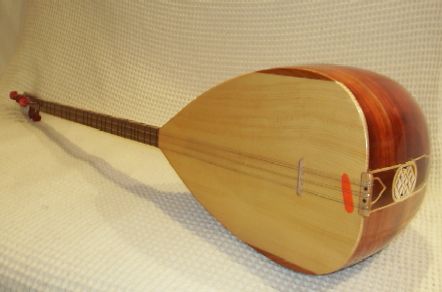- Bağlama
Infobox Instrument
name=Bağlama
names=
classification=
*Plucked string instrument s
range=
related=
*Bouzouki (Greece )
*Buzuq (Lebanon )
*Saz (Turkey )
*Tanbur
*Tar (lute) ,Dutar , andSetar (fromIran )The bağlama is a stringed
musical instrument shared by variousculture s in the Eastern Mediterranean,Near East , andCentral Asia .In Turkish, "bağlamak" means "to tie," a reference to the tied-on frets of the instrument. Like most stringed instruments, it can either be played with aplectrum (i.e., pick) or with afingerpicking style known asşelpe .Turkish bağlama
The bağlama, sometimes referred to as a
saz or a member of the saz family, is a Turkish instrument that is fundamental inTurkish folk music . Its name literally translates to "something that is tied up." It is a stringed instrument consisting of 7 strings divided into groups of 2, 2, and 3. These groups of strings can be tuned to different combinations, each corresponding to a different system.The bağlama is believed to be a synthesis of historical musical instruments in Central Asia and pre-Turkish
Anatolia .It is the most commonly used string folk instrument inTurkey , and it takes different names according to the region it's found in and its size: Bağlama, Divan Sazı, Bozuk, Çöğür, Kopuz Irızva, Cura, Tambura, etc.The cura is the smallest member of the bağlama family, with the highest-pitched sound. One size larger than the cura is the tambura, which is tuned an octave lower than the cura. The
Divan sazı is the largest instrument in the family and is tuned one octave lower than the tambura. The bağlama has three main parts, called "tekne" (the bowl); "göğüs" (sounding board ); and "sap" (neck). The "tekne" is generally made from mulberry wood but may also be made of juniper, beech, spruce, or walnut. The "göğüs" is made from spruce, and the "sap" section from beech or juniper. The tuning pegs are known as "burgu" (literallyscrew ). Frets are tied to the "tekne" with fishing line, which allows them to be adjusted. The bağlama is usually played with a "tezene" (similar to aguitar pick ) and is made from cherrywood bark or plastic. In some regions, it is played with the fingers in a style known as "Şelpe" or "Şerpe".There are three string groups, or courses, on the bağlama, with strings double or tripled. These string groups can be tuned in a variety of ways, known as "düzen". For the "bağlama düzeni", the most common tuning, the courses are tuned from top downward, A-G-D. Some other "düzen"s are "Kara Düzen" (C-G-D), "Misket Düzeni" (A-D-F), "Müstezat" (A-D-F), "Abdal Düzeni", and "Rast Düzeni". There are also electronic bağlamas, which can be connected to an amplifier. These can have either single or double pickups.The kopuz and the bağlama
The "kopuz", or "
komuz ", differs from the bağlama in that it has a leather-covered body, a fingerboard without frets, and two or three strings made of sheep gut, wolf gut, or horsehair. It is played by beating with the fingers, rather than by plucking with a plectrum.The Turkish settlement of
Anatolia from the late tenth century onward saw the introduction of a two-string Turkmendutar , which was played in some areas ofTurkey until recent times. According to the historian Hammer, metal strings were first used on a type of kopuz with a long fingerboard known as the "kolca kopuz" in 15th-centuryAnatolia . This marked the first step in the emergence of the çöğür (cogur), a transitional instrument between the kopuz and the bağlama. According to 17th-century writerEvliya Çelebi , the cogur was first made in the city ofKütahya in western Turkey. To take the strain of the metal strings, the leather body was replaced with wood, the fingerboard was lengthened, and frets were introduced. Instead of five hair strings, there were now twelve metal strings, arranged in four groups of three. Today, the cogur is smaller than a medium-size bağlama.Meanwhile, the five-string kopuz is thought to have been transformed into the six-string instrument known as the sestar or
seshane by 13th-century mysticMevlana Celaleddin-i Rumi. The word "sestar" is also mentioned in the poems of the 14th-century poetYunus Emre . Evliya Çelebi describes the kopuz as a smaller version of the seshane.The word bağlama is first used in 18th-century texts. French traveler
Jean Benjamin de Laborde , who visitedTurkey during that century, recorded that "the bağlama or tambura is in form exactly like the cogur, but smaller." He was probably referring to the smallest of the bağlama family, the cura.Bağlama (Saz) family
Note: Freq. (lower) is the frequency of the lower course; SB Length is the length of the sounding board; "sazı" is the
genitive case of "saz".Bağlama tunings
* Name Notes (lower, middle, upper) course
* Bağlama düzeni (La, Sol, Re) (A, G, D)
* Bozuk düzen, kara düzen (Sol, Re, La) (G, D, A)
* Misket düzeni (Fa#, Re, La) (F#, D, A)
* Fa müstezat düzeni (Fa, Re, La) (F, D, A)
* Abdal düzeni (La, La, Sol) (A, A, G)
* Zurna düzeni (Re, Re, La) (D, D, A)
* Do müstezat düzeni (Sol, Do, La) (G, C, A)Notable performers
*
Orhan Gencebay
*Çetin Akdeniz
*Engin Arslan
*Musa Eroğlu
*Muharrem Ertaş
*Neşet Ertaş
*Erdal Erzincan
*Hasret Gültekin
*Erol Mutlu
*Erol Parlak
*Arif Sağ
*Karl Sanders
*Haci Taşan
*Nida Tüfekçi
*Kemal Alaçayır
*Hasan Genç
*Ahmet Koç
*Fatih Doganer
*Fatih Kisaparmak
*Aşıq Abbas Tufarqanlı
*Aşıq Alı
*Aşıq Ələsgər
*Aşıq Pəri See also
*
Alevism
*Music of Turkey
*Kurdish music
*Komuz
*Dutar
*Dombra
* Greek bağlama
*Sallaneh (lute)
*Çiftelia
*Šargija
*Concerto for Bağlama External links
* [http://www.turkuler.com/baglama/baglama.asp Baglama]
* [http://www.karalahana.com/english/archive/baglama.htm All about Turkish bağlama and pictures]
* [http://lahana.org/resimler/displayimage.php?pos=-310 Bağlama pictures]
* [http://www.baglamacilar.net www.baglamacilar.net]
* [http://www.eraydinsazevi.com.tr/saz.htm http://www.eraydinsazevi.com.tr]
* [http://www.gencliginturkusu.net Bağlama ve Nota Bilgileri]
Wikimedia Foundation. 2010.
